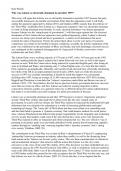Kate Patrick
Why was Labour so electorally dominant in and after 1997?
This essay will argue that Labour was so electorally dominant in and after 1997 because the party
successfully harnessed a favourable environment better than the opposition could. I will rstly
outline the argument supported by Atkins (2011) and Giddens (2000): namely that, the embrace of
the ‘Third Way’ established New Labour as a ‘hegemonic enterprise’ that was electorally dominant
in virtue of being dominant more broadly. As such, electoral dominance was almost guaranteed
because Labour was the ‘natural party of government’. I will then argue against this: the electoral
dominance of New Labour did not represent a new political hegemony, rather, Labour’s electoral
success was always provisional and never guaranteed - a surface level dominance that never
reached the status of hegemony. Firstly, the notion that Labour was the only party of economic
competence was reliant on favourable economic conditions; secondly, the positive reputation of the
party was conditional on the personality of Blair; and nally, and most damningly, electoral success
was contingent on the continued disengagement of a large pool of identity conservative voters
(Sobolewksa and Ford, 2020).
The Labour Party won a working majority of 179 seats in 1997, with a 145 seat gain on the 1992
election, marking both the largest majority the Labour Party had ever won, as well as the largest
increase in seats. With the Conservatives being reduced to a parochial English party after losing all
seats in Scotland and Wales, and retaining only 17 urban English seats, it is clear that the Labour
Party captured a geographically, ethnically, and socially broad electoral base, electorally dominating
the whole of the UK to an unprecedented extend (Coates, 2005). And yet, while the electoral
success of 1997 was certainly outstanding, it should be noted that support was consistently
declining after 1997, losing an average of 31,484 voters per month between 1997-2010, leading
Heppell and Theakston to conclude that ‘Labour’s experience under Blair and Brown was one of
attrition’ (2013: 175). Nevertheless, the fact that no previous Labour government had ever survived
more than two terms in of ce, and New Labour succeeded in winning majorities in three
consecutive elections, pushes us to question what was so different about this Labour administration
that made it so electorally successful compare to Labour governments of the past.
Labour was so electorally dominant in and after 1997 because it created a ‘hegemonic enterprise’
around ‘Third Way’ politics that made New Labour seem like the only ‘natural’ party of
government. In a post-cold war climate, the Third Way claimed to transcend the traditional left-right
dichotomy that was claimed to be redundant in a world of increasing globalisation and rapid
technological change. The ‘loony left’ of Old Labour had been over-reliant on a controlling state
and thus had failed to promote a ‘dynamic economy’ that could harness markets for social justice
aims, whereas Thatcherism had failed to take proper responsibility for the inequality and weakening
of civic society that markets could cause if the state did not have some active role. Instead, the
Third Way claimed to offer an 'integrated and robust' program that was ‘the only’ effective way of
pursuing social justice goals in an inevitably globalised world, namely that of harnessing capitalist
markets through an ‘enabling state’ marrying together both a ‘dynamic economy’ and a ‘strong
civic society’ (Giddens, 2000: 29).
The commitment to the Third Way was evident in Blair’s abandonment of Clause IV, emphasising
‘partnership’ between government an industry rather than con ict, as well as the distancing from
trade unions in the ‘fairness not favours’ policy stance. This was then communicated via 'rhetorical
and presentational strategies’ that aimed to drill the notion that Labour was the only viable
alternative to the crises of the early 90s (Atkins, 2011). This discourse was then embedded into new
institutions such as the 1997 Social Exclusion Unit (SEU), as well as institutions with past authority
such as the CBI (ibid). Blair’s use of the rebranded name ‘New Labour’ 37 times in just one speech
in 1995 further seeded the ground for the wide acceptance that the Third Way was the only way, and
that Labour was now its vehicle (Coates, 2005: 27). Given this line, it is no surprise that the
fi fi fl fi




